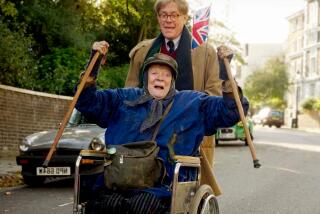The Belle of Lettres : SOUTHERN DAUGHTER: The Life of Margaret Mitchell, <i> By Darden Asbury Pyron (Oxford University Press: $29.95; 560 pp.)</i>
- Share via
Arguably, the subject of “Southern Daughter: The Life of Margaret Mitchell” by Darden Asbury Pyron is as fascinating as Mitchell’s famous heroine, Scarlett O’Hara. She was, for much of her life, what novelist Reynolds Price said of Southern women in general: “a Mack truck disguised as a powder puff.”
Margaret Mitchell was prey in the extreme to all the demons that afflicted Southern women of her time. These include a need for the appearance of propriety, whatever the reality, along with a reverence for “ladylike” behavior in all cases despite the cost; a sense of duty toward others--especially toward family and clan, and in the case of women of Mitchell’s generation, the maternalist care of the blacks who were such an important part of their lives--that often precluded proper care of oneself.
In Mitchell’s case, this need to present oneself in a certain manner--a manner that her own mother, May Belle Stephens, perfected-- was continually at odds with her feisty nature. As a child she was taught both riding and shooting, and was required to read the classics before age 12, after which “she gave herself over to romances and adventures, dime novels, and cheap thrillers.” Later, she became one of the few debs blackballed by the Junior League after performing a scandalous rendition of an Apache dance at a charity ball.
She had a failed first marriage; and she worked--as a feature writer on the Sunday Magazine of the Atlanta Journal--during a time when women in her social milieu rarely held jobs other than in teaching or social work. And though childbearing was a marital imperative of her day, Mitchell had all aversion to becoming a mother herself--perhaps because of the self-sacrifice she had observed, her conflicted feelings about her mother and grandmother.
Through carefully accrued detail, biographer Pyron leads us step by step through Mitchell’s character and literary development--the exposure to literature and Southern oral history, sometimes provided by living Civil War veterans; her training to become, in many ways, both the kind of woman Scarlett was, and the kind of woman Melanie was. For that is the dilemma of the Southern woman: Ideally, she is Scarlett--flirtatious, secretive, frigid; and Melanie--long-suffering, selfless, loving.
Thus, by the time Mitchell begins writing--secretly, anything else would have been too self-serving, too assertive--her massive tome, then distributing it in dirty envelopes (some even used as rests for her bad back) throughout the tiny basement apartment she shares with her second husband, John Marsh, it seems perfectly organic to the reader: simply a literate Southern lady’s way of passing the time while enduring a variety of ailments. Indeed, this book could be retitled, “The Story of a Typical Southern Woman of Her Times--Who Just Happened to Become an Internationally Famous Novelist.”
Indeed, Mitchell’s ailments--which seem to increase with every passing year, necessitating all kinds of minor surgeries and periods of recuperation--appear almost as rage surfacing in one who had little other outlet for that anger. Her need to be self-effacing, charming and self-sacrificing at all times must have taken its toll. Her body seemed to have been the battlefield--a constant conflagration, after her early 20s, of everything from internal problems (“Just about everything below my waistline was out of place and growing to everything that they shouldn’t”) to persistent boils, calling for round spots to be shaved from her head “varying from the size of a silver dollar to a penny, (giving) me a curious piebald look,” as she wrote editor Harold Latham after he asked for a photograph.
Publication, and subsequent fame, did little to free Mitchell from her internal stresses: She felt compelled to respond to each individual situation in a way that related to her early training--from answering thousands upon thousands of letters individually, and at great cost to herself, to insisting on a certain moral code in dealing with slippery Hollywood lawyers.
During the last years of her short life, she seemed to spend more of her time in a state of indignation over what she deemed to be many injustices than in any other way. Indeed, what happened to Mitchell after the publication of the world’s most famous novel is a negative lesson for aspiring writers who assume fame and money would be an end to their problems. She became a bitter woman, the anger that had been long building surfacing along with a reactionary political attitude that went beyond mere conservatism.
Along with her hypochondria, Mitchell feared automobiles and driving throughout her life. Thus there is a certain irony in the fact that at age 47 she died from injuries after being hit by a car driven by a drunken driver as she crossed her beloved Peachtree Street with ailing husband John, on their way to see a movie at the Arts Theatre.
In any case, Pyron builds, in this comprehensive biography, a mosaic that describes a life, to the point that we feel that we know Margaret Mitchell well--almost too well, for the portrait is not always pretty.
For example, early in the book, Mitchell asks at Smith College to be placed in another history class when the one to which she has been assigned has a Negro member; but this incident merely hangs there, unexplained, leaving one wishing Pyron had done a bit more analysis of Mitchell’s attitudes toward race and class.
Pyron also includes some delicious tidbits on the creation of “Gone With the Wind,” such as the fact that Rhett’s speech in which he declares that “This isn’t the first time the world’s been upside down, and it won’t be the last” came almost directly from Mitchell’s mother, May Belle; and that two other titles she considered were “Tote the Weary Load” and “Tomorrow Is Another Day.”
But by the conclusion of “Southern Daughter,” the reader mainly feels that he or she knows Margaret Mitchell, the woman, intimately--including a clear picture of the motivations, denials and imprints that might have been invisible to the subject herself.
And isn’t that what good biography is all about?
More to Read
Sign up for our Book Club newsletter
Get the latest news, events and more from the Los Angeles Times Book Club, and help us get L.A. reading and talking.
You may occasionally receive promotional content from the Los Angeles Times.










